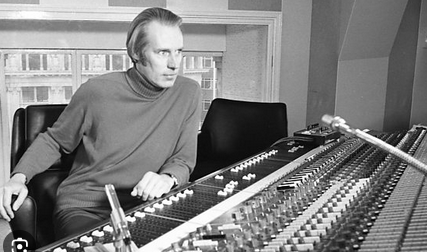Continuing the vison of Sir George Martin at Troubled Clef Studios
This article explains the Why behind Troubled Clef Studios. Many have said we are mad to have built this. But if you really want to understand why we did, read this article for the answers.

Troubled Clef Studios happens to exist in a town with a rich and long history of art. Our home, in San Miguel de Allende, Mexico, is a cultural center in Latin America and yet has gone generally unnoticed on the world stage other than its beautiful historic buildings and architecture. Yet this is a place with long history of embracing art in all of its forms.
We feel honored to be here. The economics of Mexico and San Miguel de Allende allow artists to flourish without the expenses of big cities like New York, Paris, London, Los Angeles, etc. This is a gift to artists. A place to think and contemplate without the stress of the modern urban city. Where one can see the world and comment upon it, tell stories and maybe help others realize the forest for the trees.
And yet we are part of the world. We are part of humanity and we just as active here as agents of change as anyone in an urban center. There is always a risk in retreating to a place of peace like San Miguel de Allende, that you lose your edge and your power. But that is far from what is happening here.
In fact, what is happening is conjuring the past to create the future.
Sir George Martin’s vision on the island of Montserrat
Our recording studio’s “live room” is an exact replica of AIR Studios Montserrat’s live room. This iconic recording studio that was built in 1978 and ceased to operate in 1989, had a short history but changed culture. Artists that are now considered legendary traveled to this island in the Caribbean – in the middle of nowhere – to create. To understand it, is to understand Troubled Clef Studios and its vision.
Sir George Martin was the legendary producer of The Beatles. But he did much, much more that most people forget. Sir George was an agent of change. In the early 1960s, he founded the Association of Independent Recordists ( or “AIR”) as he would embrace the acronym. AIR was a collective of recording engineers who had previously been on staff at various media companies. They were generally poorly paid – on salaries – and Sir George took the risk of creating the concept of a producer.
While the C-Suite at the media companies were living large, the staff were often not. The staff not only recorded the artists, but added value and involve themselves in helping the artist to flourish. They might offer arrangement ideas, or suggestions. Sometimes they were invited to be co-writers on material. Often they played the role of psychologist, because they knew what was required to unveil the art from the artist. These things were above & beyond the norm of the role of a recording engineer, Sir George felt that the producer needed to be a stakeholder in the final product.
He was one of the first to float the idea of “points” on a recording, where a small percentage of royalties for the final recorded product was directed to the producer. He left his employment to be an independent producer, and the rest is history. He found four scruffy young musicians in Liverpool (The Beatles) and produced their albums. He helped them discover their greatness and we are blessed to have the final recorded product from that era that changed what we think of modern popular music.
After the demise of The Beatles in the late 1960s, Sir George took his new found fortune and built a large recording studio in London. AIR Studios, as he named it, was the center of activity throughout the 1970s in London and featured the best technology & talent of the time. It, however, suffered from being in a busy urban city. The reputation and legendary status that he held brought all the right but often the wrong elements to the doors of AIR London. The paparazzi would camp out at the front of the studio – waiting for a celebrity to walk in. The stress was enormous and it affected art. It affected the creativity.
Years later, Sir George found himself on a flight in which he saw an article in the back of an In-Flight magazine about this magical island in the Caribbean called Montserrat. He embraced a mission of finding a solution for a place in which artists could create without the stress & distractions that had built up around London at the time. He floated an idea of building a recording studio on a ship and had to go out into the ocean to isolate the artists but that came with the issues of noisey diesel engines that was the enemy of the recording studio.
He thought that maybe an island that was naturally isolated and far away could be the answer. He discovered the island of Montserrat and he and his wife fell in love with it. Despite the logistical challenges of building a world class recording studio there, he prevailed and with his loyal team, they built a place that art could once again flourish. The beauty of the island life allowed for the creation of iconic albums from his clients. The Police, Dire Straits, Duran Duran, Rush, Elton John, The Rolling Stones, Stevie Wonder, Paul McCartney and countless others all went there and recorded. But ultimately nature reclaimed it. In 1989, a hurricane wiped out much of his studio and home. Even though it could have been saved, the desire to do it waned. This was the time of the compact disc, changes in musical styles that moved away from the 1980s to Grunge and the post-punk revolution. However Sir George held onto his land and his property. But in 1995, the final nail in the coffin for AIR Montserrat came when a volcano on the island erupted and a massive catastrophy claimed much of the island – with the studio being cut off from resources and forced into what they call “the exclusion zone”.
To this day, the studio still stands but as a termite infested shell. It can never be recovered due to the toxic nature of a post apocalyptic eruption. And so it was entombed.
But the idea of a paradise for the creation of art still remained.
Technology & music
The one thing that is often forgotten is that the renaissance of music of the 1960s, 70s and 80s came because of technology. Prior to Sir George’s work in Abbey Road Studios in London in the 1960s, recording was done with one or two tracks. There were microphones in big rooms, but no multi-track tape recorders. The artists would perform together and be recorded – they were the mix of sounds in real time that was captured. Eventually the likes of Les Paul and his creation of the multi-track tape recorder emerged. Some studios took risks on it in the 1960s and eventually the 4 track studio was created. Then the 8 track and finally the 24 track studio became the defacto standard for recording in the 1970s as the technology progressed.
This meant that you could have many microphones separately recording. Many musicians isolated and separated but then to bring it all back together in a mix of sound that resulted in the records that we know and love today.
The technology was an empowering and enabling tool. It spawned a new era of acoustic exploration, and ushered in effects units, synthesizers, samplers, distortion, compression, EQ, etc. that all became tools of the sound recordist. And the production of media that could hold, in perpetuity, the recordings made with this technology became mainstream. Vinyl long playing recordings (or “LPs” as we would refer to them) and turntables and Hi-Fi systems became affordable. Now everyone could experience the music in its glory. This moved into the digital age in the 1980s with CDs.
Technology is a double-edged sword. As a tool, it allows a proficient sound recordist with a talented artist or band to create a brilliant recording. However if the recordist is not properly trained or has no connection to the music that they are recording, it runs the risk that the tool controls the end result. This routinely creates neutral results – since those using the tool rely solely on the tool to do the work, rather than their vision and technique, everything sounds the same because the same tools are doing it. This is further amplified with more technically advanced things such as artificial intelligence, in which the tool does ALL the work including the creation and the musician is no longer relevant.
The entire point of creating an environment for musicians to flourish is to understand the human experience, our doubts, fears, hopes, loves, anger, and all the other emotions that make us human. To synthesize that, or remove it entirely, is the antithesis of this and why most modern recording studios are shutting down and going away.
Sir George knew that technology was a tool – but a tool that humans must use. And that, like a hammer in the right hands, can create great furniture. But in the wrong hands, is a weapon of destruction.
When I hear people complaining that everything sounds the same these days, or that there isn’t any risk taking in music anymore, or that music has lost its edge, I know why. The technology (the tools) became the focus and the human using it became submissive and irrelevant. Sir George coined the term “producer” in the 1960s because he knew the role that he was playing in creating the likes of The Beatles. But today, that term has been pasteurized and homogenized and no longer means anything. Musicians think they are “producers” because they produce a recording on their laptop. DJs think they are producers because they produce a mashup of sounds for a club. Some engineers still hold on to the traditional definition of the term that came from Sir George, but they are all threatened by the tools doing their job for them.
And yet here is the dilemma. Humans need to create art because humans consume it. Not machines, tools or technology. If those things are not used by humans to create something that culturally represents who we are, then we are doomed. Art is the one thing that we have that really represents who we are as a species. It allows communication of feeling and sensitivity that you can’t successfully synthesize.
Sir George knew the balance between technology and art, but ultimately backed the humans that created the art. He created a safe place for them to create the best recordings of their lives in the Caribbean. It may not have lasted more than 10 years, but it was legendary.
Carrying on the tradition
Troubled Clef Studios is the vision of Myles Wakeham, and opens in 2026 in San Miguel de Allende. This is a place of refuge and solace for musicians to get back to who they are – humans. To have a safe place where the human experience can be explored in music. Not to run away from it, but to run into it.
In the shadow of AIR Montserrat & Sir George’s vision, Troubled Clef partnered with those still alive who built AIR Montserrat and created legends. We hunted far & wide all over the world for the right technology – both the latest tools that could be used for the creation of music, but similar technology to what existed in the past that created legends. Some things are museum pieces, and other things are modern day items of wonder.
All with the vision of supporting the human. We don’t avoid the struggle that it takes to create great art. We embrace it. We don’t defer the creation to AI. We confront it head on, and we make it comfortable.
San Miguel de Allende brings its power to the process by creating a place away from the stress of the modern world. The lower costs of living here compared to modern urban cities means that one can stay longer and really find the art they are looking to present. The restaurants and cafes, the beautiful architecture, the history, the people… It all is part of the story. Much in the same way Sir George found the jewel in Montserrat, we found the same in San Miguel de Allende. We are standing on the shoulders of the giants that came before us, and we are part of history. This is something we want Mexico to be proud of, and that it can stand on the world stage alongside such great studios as Abbey Road, AIR, Albert Studios, East/West, Blackbird, etc. and be a destination for the creation of art.
If you believe in these ideals as we do, join us. If you believe that art needs a future that isn’t defined by the tools but by the humans, join us. If you ever ask why music has become passe and doesn’t reflect the human story anymore, join us. Troubled Clef Studios offer an affordable destination studio experience for those serious about their art and changing the world with it.

